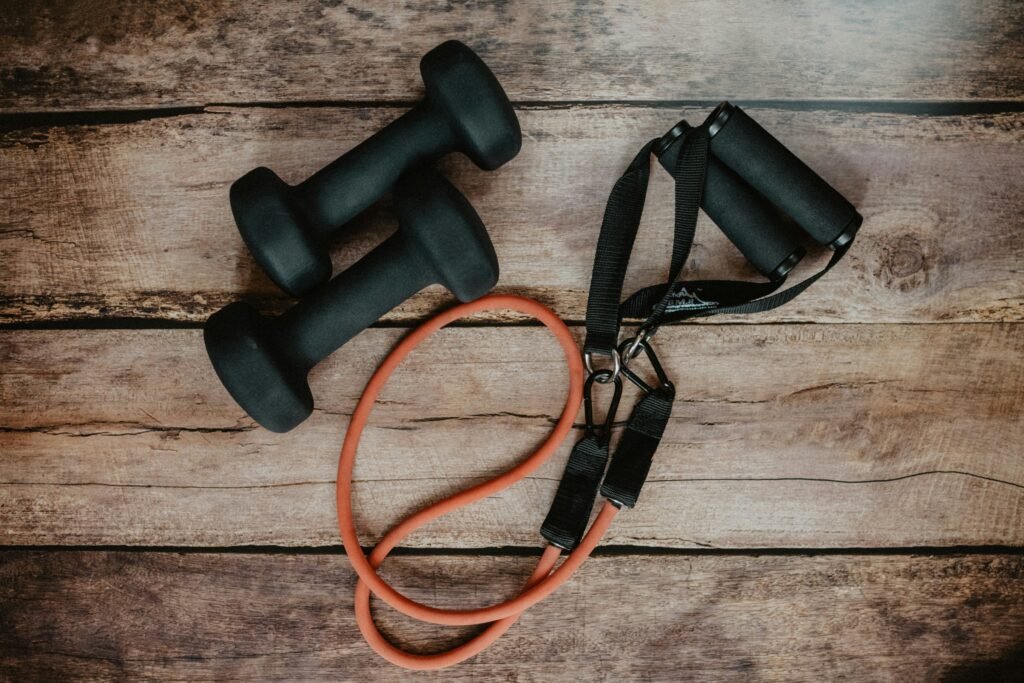Maximizing Muscle Growth with Resistance Bands
Ready to take your muscle-building game to the next level? In this article, we will explore the multiple benefits of incorporating resistance bands into your workout routine to maximize muscle growth. Whether you’re a beginner looking to increase strength or a seasoned gym-goer wanting to switch up your routine, resistance bands offer a versatile and effective way to challenge your muscles and achieve the results you desire. Learn how to target specific muscle groups, increase intensity, and prevent plateaus with the help of these simple yet powerful exercise tools. Get ready to see those muscles grow like never before!
Maximizing Muscle Growth with Resistance Bands
Have you ever wondered how you can take your muscle growth to the next level without having to invest in expensive gym equipment? If so, you’re in luck! In this article, we will explore how you can maximize your muscle growth using resistance bands.

This image is property of images.unsplash.com.
Why Resistance Bands?
Resistance bands are a versatile and cost-effective tool for enhancing muscle growth. They offer a wide range of resistance levels, making them suitable for beginners as well as advanced lifters. Additionally, resistance bands are portable, making them convenient for at-home workouts or when traveling.
If you’re looking to add variety to your workout routine, resistance bands are an excellent choice. They can target specific muscle groups that may be neglected with traditional free weights, helping you achieve a more balanced physique.
Benefits of Using Resistance Bands
Resistance bands offer several benefits that can help you maximize muscle growth. Some of these benefits include:
- Versatility: Resistance bands can be used for a variety of exercises, targeting different muscle groups.
- Portability: Resistance bands are lightweight and easy to transport, making them ideal for home workouts or when traveling.
- Adjustable Resistance: Resistance bands come in different levels of resistance, allowing you to gradually increase the intensity of your workouts.
- Joint-Friendly: Resistance bands provide a smooth and consistent resistance, reducing the risk of joint strain or injury.
- Cost-Effective: Resistance bands are more affordable than traditional gym equipment, making them a budget-friendly option for building muscle.
By incorporating resistance bands into your workout routine, you can take advantage of these benefits to maximize your muscle growth effectively.
Types of Resistance Bands
Before getting started with your resistance band workouts, it’s essential to understand the different types of resistance bands available. Each type of resistance band offers unique advantages and can be used for specific exercises.
Loop Bands
Loop bands are the most common type of resistance bands and are often used for lower body exercises such as squats, lunges, and hip thrusts. They come in various resistance levels, ranging from light to heavy, allowing you to target different muscle groups effectively.
Tube Bands
Tube bands consist of a flexible tube with handles on both ends, making them ideal for upper body exercises like bicep curls, tricep extensions, and shoulder presses. They also come in different resistance levels, providing a challenging workout for your arms, chest, and back.
Figure 8 Bands
Figure 8 bands are designed in the shape of a figure eight and are excellent for targeting the upper body muscles, including the chest, shoulders, and back. They offer consistent resistance throughout the range of motion, making them ideal for building strength and muscle endurance.
Therapy Bands
Therapy bands are flat resistance bands that are often used for rehabilitation and physical therapy purposes. However, they can also be used for strength training exercises, particularly for beginners or individuals recovering from injuries.
By understanding the different types of resistance bands and their unique characteristics, you can choose the right bands for your workout goals and preferences.

This image is property of images.unsplash.com.
How to Use Resistance Bands for Muscle Growth
Now that you’re familiar with the benefits of resistance bands and the various types available, let’s explore how you can use them to maximize muscle growth effectively. Incorporating resistance bands into your workout routine can help you target specific muscle groups, increase overall strength, and enhance muscle definition.
Full-Body Workouts
One of the most effective ways to use resistance bands for muscle growth is by incorporating them into full-body workouts. Full-body workouts involve targeting multiple muscle groups in a single session, allowing you to maximize your time and effort efficiently. You can perform a variety of exercises using resistance bands, such as squats, lunges, rows, and shoulder presses, to engage different muscle groups and stimulate overall muscle growth.
Isolation Exercises
In addition to full-body workouts, you can also use resistance bands for isolation exercises to focus on specific muscle groups. Isolation exercises target individual muscles, helping you develop muscle definition and symmetry. Some isolation exercises you can perform with resistance bands include bicep curls, tricep extensions, lateral raises, and leg extensions. By incorporating isolation exercises into your routine, you can address weak areas and achieve a well-rounded physique.
Progressive Overload
To maximize muscle growth with resistance bands, it’s essential to apply the principle of progressive overload. Progressive overload involves gradually increasing the resistance or intensity of your workouts over time to continue challenging your muscles and promoting muscle growth. You can achieve progressive overload with resistance bands by using bands with higher resistance levels or increasing the number of repetitions and sets in your workouts. By progressively overloading your muscles, you can stimulate muscle hypertrophy and strength gains effectively.
Superset Training
Superset training is another effective strategy for maximizing muscle growth with resistance bands. Supersets involve performing two exercises back-to-back with minimal rest in between, targeting the same muscle group or opposing muscle groups. For example, you can perform a set of bicep curls followed by tricep extensions to exhaust the arm muscles and stimulate muscle growth. Superset training with resistance bands can help increase muscle endurance, maximize time under tension, and enhance muscle definition.
Resistance Band Circuit Training
Circuit training involves moving quickly from one exercise to the next with minimal rest, challenging multiple muscle groups and boosting cardiovascular fitness. You can create a resistance band circuit by combining different exercises in a circuit format, such as squats, push-ups, rows, and lunges. Performing resistance band circuit training can help improve muscular endurance, burn calories, and enhance overall fitness levels.
Sample Resistance Band Workouts for Muscle Growth
To give you a head start on maximizing muscle growth with resistance bands, here are a couple of sample workouts that you can incorporate into your routine. These workouts are designed to target different muscle groups, provide a challenging workout, and promote muscle growth effectively.
Lower Body Workout
- Squats: 3 sets of 12-15 reps
- Lunges: 3 sets of 12-15 reps per leg
- Hip Thrusts: 3 sets of 12-15 reps
- Leg Press: 3 sets of 12-15 reps
- Calf Raises: 3 sets of 15-20 reps
Upper Body Workout
- Bicep Curls: 3 sets of 12-15 reps
- Tricep Extensions: 3 sets of 12-15 reps
- Shoulder Press: 3 sets of 12-15 reps
- Bent-Over Rows: 3 sets of 12-15 reps
- Chest Press: 3 sets of 12-15 reps
Full-Body Circuit
- Jump Squats: 3 sets of 20 reps
- Push-Ups: 3 sets of 15 reps
- Bent-Over Rows: 3 sets of 12 reps
- Plank: 3 sets of 30 seconds
- Russian Twists: 3 sets of 20 reps
Incorporate these sample workouts into your resistance band training routine to target different muscle groups, stimulate muscle growth, and make progress towards achieving your fitness goals.

This image is property of images.unsplash.com.
Tips for Maximizing Muscle Growth with Resistance Bands
As you continue to incorporate resistance bands into your workout routine to maximize muscle growth, consider the following tips to enhance your training experience and achieve optimal results:
- Focus on Proper Form: Pay attention to your form and technique when performing resistance band exercises to avoid injury and maximize muscle engagement.
- Gradually Increase Resistance: Progressively increase the resistance level of your bands to continue challenging your muscles and stimulate muscle growth effectively.
- Include Variety in Your Workouts: Keep your workouts interesting and effective by incorporating a variety of exercises, rep ranges, and training techniques with resistance bands.
- Listen to Your Body: Pay attention to your body’s signals, rest when needed, and adjust your workout intensity based on your energy levels and recovery.
- Stay Consistent: Consistency is key to maximizing muscle growth with resistance bands, so make exercise a regular part of your routine and stay committed to your fitness goals.
By following these tips and implementing them into your resistance band training routine, you can optimize your muscle growth potential, see progress in your strength gains, and achieve the physique you desire.
Final Thoughts
In conclusion, resistance bands are a valuable tool for maximizing muscle growth and enhancing overall strength and fitness. By incorporating resistance bands into your workout routine, you can target different muscle groups, apply progressive overload, and perform various training techniques to stimulate muscle hypertrophy effectively. Whether you’re a beginner looking to build muscle or an advanced lifter seeking to add variety to your workouts, resistance bands can help you achieve your fitness goals and make progress towards a stronger, healthier body. Start incorporating resistance bands into your routine today and experience the benefits of this versatile training tool for yourself!
